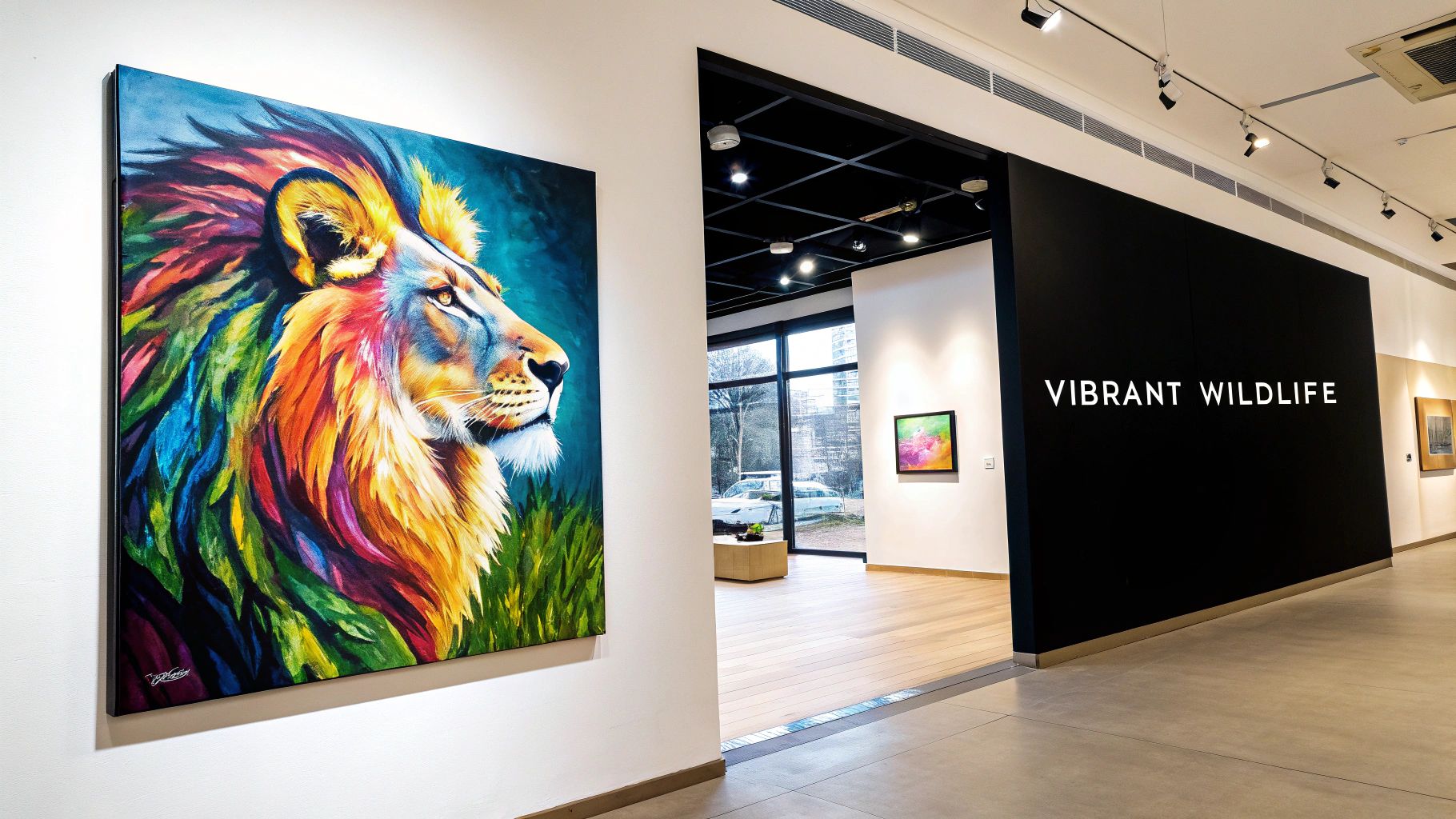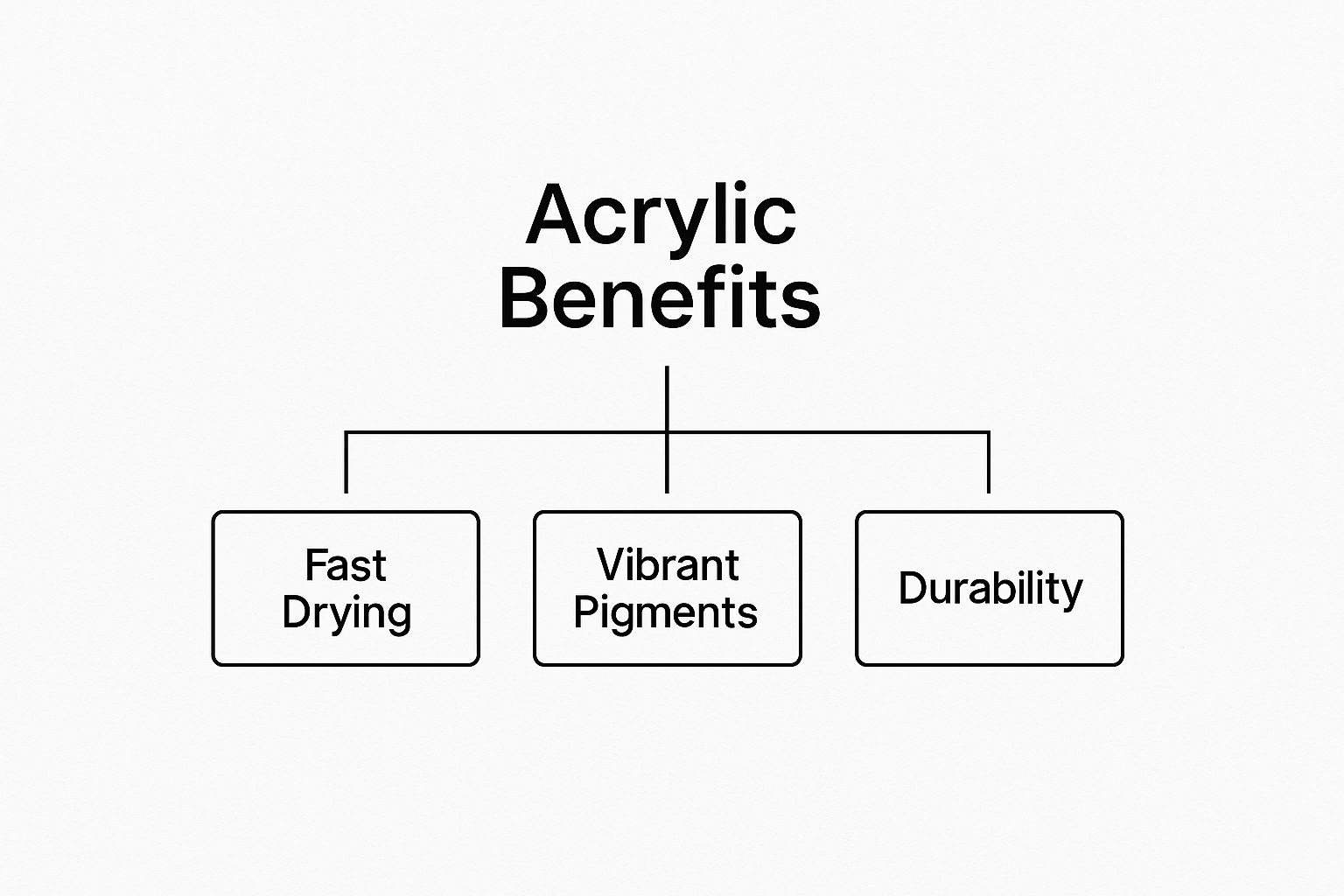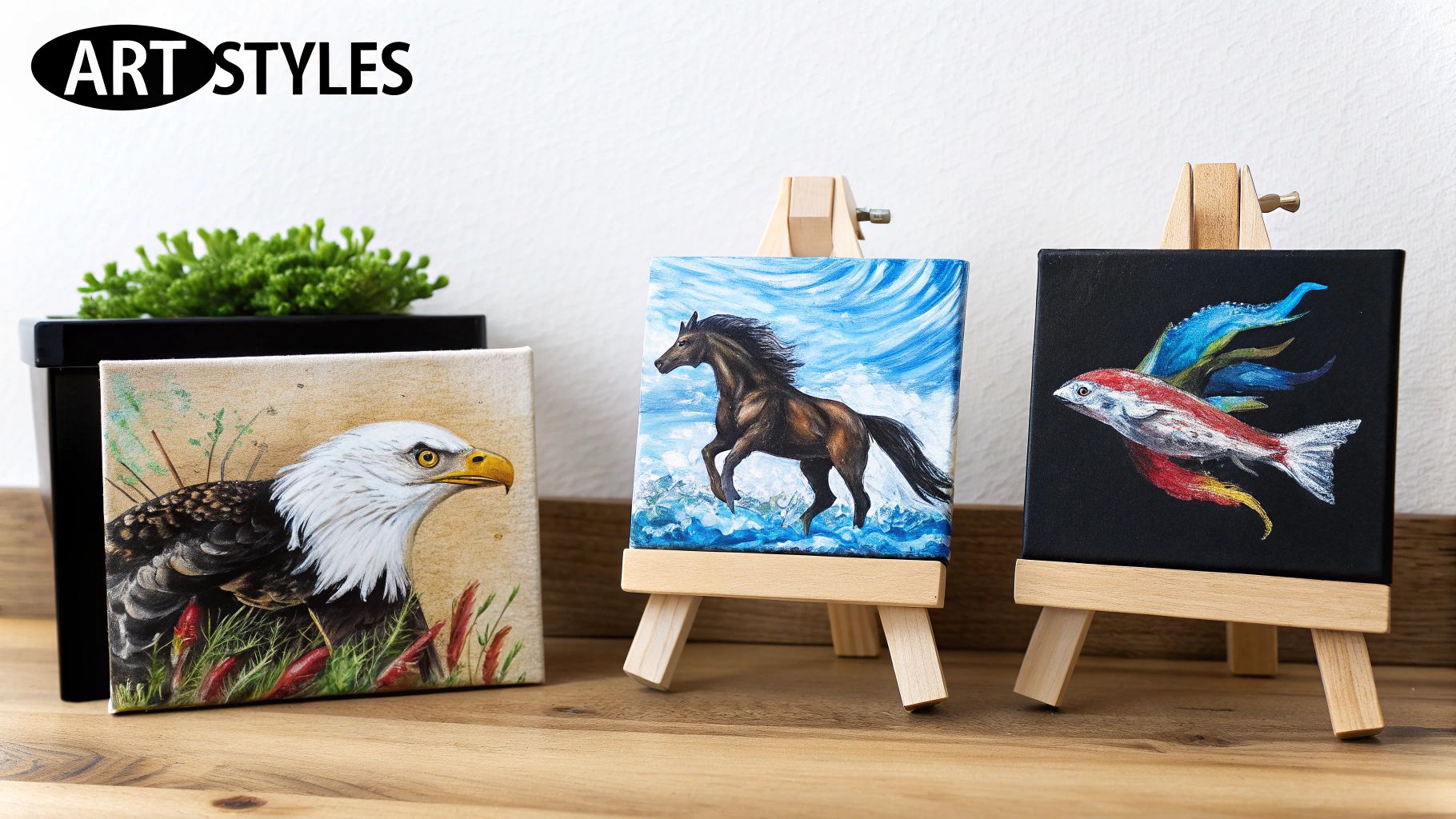Welcome to the captivating world where wildlife and vibrant color collide. Acrylic paintings of animals are more than just an art form; they're a way for artists and collectors alike to connect with the untamed spirit of the animal kingdom. This guide will walk you through everything you need to know, from artistic techniques to building your own collection.

The Enduring Appeal of Animal Acrylic Paintings
From the powerful gaze of a wolf to the delicate flutter of a hummingbird's wings, animals have inspired artists for centuries. Acrylics, though, bring something fresh and dynamic to the table, offering a modern way to bring these creatures roaring to life on canvas.
The medium’s versatility is what makes it so special. It allows for a stunning range of expression, from hyper-realistic portraits that feel almost photographic to bold, abstract works that just capture an animal’s essence with a few powerful strokes. This unique blend of subject and medium creates artwork that connects with us on an almost primal level. It’s more than just decoration; it's a celebration of nature, a statement of passion, or a deeply personal tribute to a beloved pet.
Why We Connect With Animal Art
There's a reason we're so drawn to animal art—it's woven into our shared history and environment. These paintings don't just show you an animal; they tell a story and stir up powerful emotions. That’s the real secret behind their popularity.
- Emotional Resonance: A great artist can capture an animal’s personality—its strength, vulnerability, or goofy playfulness—creating a piece that feels like it’s looking right back at you.
- A Celebration of Nature: For many of us, owning a piece of wildlife art is the perfect way to bring the wild beauty and majesty of the outdoors into our homes.
- Conservation and Awareness: Many artists use their work to shine a light on the plight of endangered species. Suddenly, a beautiful painting becomes a powerful conversation starter about our responsibility to the planet.
The magic of this art form is its ability to freeze a moment of pure wildness. An artist using acrylics can build up layers of fur, feathers, and scales with a speed and precision that other mediums just can't match, giving the final piece an incredible sense of life and energy.
Ultimately, these paintings are a testament to the profound bond between humanity and the animal kingdom, captured one vibrant brushstroke at a time.
Why Artists Choose Acrylics for Animal Portraits
So, what is it about acrylics that makes them the perfect match for painting animals? While every medium has its own personality—from the slow, buttery blend of oils to the ethereal flow of watercolor—acrylics bring a unique blend of practicality and creative freedom to the canvas. They’re a powerhouse for capturing the wild.
Imagine trying to paint a snow leopard. With oils, you'd be waiting days for that first layer of thick, white fur to dry. But with acrylics? You're ready for the next layer in minutes. That fast drying time isn't just a nice bonus; it's a massive advantage when you're trying to build up the complex textures you see in nature.
This speed lets artists almost sculpt with paint. You can layer color over color to create incredible depth and realism, building everything from the tough, wrinkled hide of a rhino to the shimmering, delicate shell of a beetle. It’s this process of building and refining that makes acrylic paintings of animals pop with such stunning detail.
Speed and Precision in Capturing Wildlife
The quick-drying nature of acrylics is a strategic tool. It allows for sharp, defined edges and makes it possible to add tiny details—like the fine whiskers on a cat or a little glint in an eye—without smudging the colors underneath.
This kind of precision is everything when you're painting animals. Every little marking helps define the creature's personality and expression. An artist can lay down the base colors and then confidently move on to the intricate patterns of a zebra's stripes or a giraffe's spots.
This infographic breaks down why so many wildlife artists swear by acrylics.

As you can see, the big draws are speed, vibrancy, and longevity. Together, they create a versatile toolkit that's hard to beat for animal portraiture.
Vibrancy and Durability That Last
Beyond just being fast, acrylics are known for their brilliant color and permanence. The pigments are held in a polymer emulsion that becomes water-resistant and incredibly tough once it dries. This means the fiery reds of a macaw or the deep, inky blacks of a panther won't fade or yellow over the years.
That kind of longevity gives both the artist and the collector peace of mind, knowing the artwork will stay as vivid as the day it was finished. It’s no surprise the medium is so popular. The global market for artist-grade acrylics hit $535.4 million back in 2021 and is still growing. This trend is driven by artists who need that superior pigment quality and permanence for detailed work like animal portraits. You can dig deeper into the artist-grade acrylics market to see the numbers for yourself.
In essence, acrylics offer artists the best of both worlds: the speed to capture a fleeting moment of wildness and the durability to make it last forever.
It’s this powerful combination that makes the medium a natural fit for anyone dedicated to capturing the soul and texture of the animal kingdom.
Exploring Popular Styles in Animal Acrylic Art
Ever walk through a gallery and wonder why one painting of a tiger looks like a photograph, while another is a whirlwind of color and energy? That's the magic of artistic style. When it comes to acrylic paintings of animals, artists have an incredible range of approaches, each telling a completely different story.
Think of it this way: a wildlife photographer uses different lenses to capture a scene. An artist uses a different stylistic "lens" to express their vision. Some are zoomed in on every tiny detail, while others pull back to capture the raw emotion of a moment. Let's dive into some of the most popular styles you'll come across.

Photorealism and Hyperrealism
This is the style that makes you stop and ask, "Wait, is that a painting or a photo?" And that’s exactly the point. Photorealism aims to recreate an image with such stunning accuracy that it becomes almost indistinguishable from a high-resolution photograph. Artists in this genre are absolute masters of their craft, patiently rendering every strand of fur, shimmering scale, and delicate feather.
Hyperrealism pushes this idea even further. It's realism with an emotional punch. While it looks just as real, the artist often infuses the scene with a mood or narrative that a camera might not capture, making the animal feel intensely present and alive.
This style is a true test of patience and technical prowess. An artist can pour hundreds of hours into a single piece, using the tiniest brushes to nail the glint in an animal's eye or the intricate pattern on a butterfly's wing.
Impressionism and Expressive Art
On the other side of the coin, we have impressionism. If photorealism is about what the eye sees, impressionism is about what the heart feels. Here, the focus shifts to capturing a fleeting moment—the play of light, the blur of motion, the pure energy of the subject.
Forget sharp, perfect lines. Instead, you'll see bold, visible brushstrokes and a rich, often exaggerated color palette. Imagine a painting of a running horse. The artist isn’t focused on painting every muscle; they're capturing the sensation of speed and wild freedom. It’s this spontaneous, emotional quality that makes these pieces so captivating.
Abstract and Stylized Interpretations
Ready to leave reality behind entirely? Abstract animal art does just that. Artists use shape, color, and texture to communicate the essence of an animal rather than its physical form. A fox might become a dynamic slash of fiery orange and white, suggesting its sly, quick nature without a single realistic detail.
Stylized art sits somewhere in the middle, where the animal is recognizable but depicted with unique exaggerations or simplified forms. Both approaches are deeply personal and invite you to bring your own imagination to the table.
To make it even clearer, here’s a quick breakdown of how these styles compare.
Comparing Styles of Acrylic Animal Painting
| Style | Primary Goal | Key Characteristics | Best For Depicting |
|---|---|---|---|
| Photorealism | To create a painting indistinguishable from a photograph. | Extreme detail, smooth finish, precise replication of textures (fur, feathers, scales). | The quiet majesty of a resting lion or the intricate detail of an insect. |
| Impressionism | To capture the feeling and light of a fleeting moment. | Visible brushstrokes, vibrant colors, focus on movement and atmosphere over detail. | A herd of horses galloping across a field or birds taking flight at sunrise. |
| Expressive | To convey deep emotion and the artist's personal response. | Bold, often non-naturalistic colors, distorted forms, dynamic and energetic application of paint. | The fierce energy of a predator or the gentle spirit of a beloved pet. |
| Abstract | To represent the animal's essence or spirit through non-literal forms. | Use of shape, color, and line to evoke a feeling; the subject may not be immediately recognizable. | The speed of a cheetah as a blur of spots or the power of a whale as a massive, sweeping form. |
Understanding these different approaches opens up a whole new world of appreciation. It helps you see beyond the subject and connect with the artist's intent, allowing you to find the pieces that truly speak to you.
Essential Techniques for Painting Animals with Acrylics
https://www.youtube.com/embed/grHbGMllpKw
Have you ever looked at a painting and wondered how the artist captured the incredibly soft look of a rabbit's fur or the wet glint in a wolf's eye? It’s not magic, but it is a kind of alchemy that comes from mastering a few core techniques. These skills are what transform a flat splash of color into a living, breathing creature on the canvas.
One of the most important methods is layering. Think of it like telling a story, one sentence at a time. You start with a simple base color, then you build on it with thin, successive layers of paint. Each new coat helps to refine the animal's shape, introduce subtle color shifts, and create the deep, rich tones you see in professional acrylic paintings animals. It's a patient process, but it's what gives the final piece a sense of realism and dimension that one thick coat of paint just can't match.
Creating Lifelike Textures
To really bring an animal's coat to life, artists often grab a stiff brush for a technique called dry brushing. It's exactly what it sounds like: using a brush with very little paint on it and lightly dragging it across a dry surface.
- For Fur and Hair: This is the go-to method for creating the illusion of fine, individual hairs. It gives a soft, wispy texture that’s perfect for mammals like foxes, bears, or your favorite fluffy cat.
- For Feathers: In the same way, dry brushing can mimic the delicate, overlapping structure of bird feathers, making them look light and airy.
- For Rough Skin: It can even be used to suggest the weathered, tough hide of an elephant or a rhinoceros.
The secret here is all about control. By changing the pressure and direction of the brushstrokes, an artist can build up texture that feels so authentic you'll want to reach out and touch it.
Adding Depth with Glazing and Washes
Finally, to get that luminous glow and those subtle shifts in color, artists use glazing. This is where you apply a super thin, transparent layer of color over a part of the painting that's already dry. It’s almost like putting a colored filter over a photograph—it doesn't hide the details underneath but tints them, adding a new level of depth and richness.
A wash is a similar idea, but it uses more watered-down paint to cover larger areas. It's great for laying down backgrounds or blocking in the initial colors. If you want to see exactly how artists put these ideas into practice, this guide on painting animals in acrylic is a fantastic resource.
And don't forget light! Understanding how light and shadow play across a subject is everything. Even tips from outside the painting world, like those for understanding professional photography lighting setups, can offer huge insights into how to make your subject pop. By blending these foundational techniques, an artist can do more than just paint an animal—they can capture its spirit.
Ready to Start Your Own Animal Art Collection?

So, you're thinking about bringing a piece of the wild into your home? That's fantastic. Starting an art collection might sound intimidating, but it’s really just about finding pieces that you truly connect with. The best place to start is by setting a realistic budget. Knowing what you're comfortable spending makes the whole search feel less overwhelming and way more fun.
Once you have a number in mind, the real adventure begins: exploring. Dive into the work of artists you admire. Follow them on social media, browse their websites, and maybe even sign up for their newsletters. It's a great way to discover new art and get a feel for the story and skill behind each painting.
How to Choose That First Perfect Piece
When it comes to picking out your very first painting, the number one rule is simple: trust your gut. Art is personal, so buy what you genuinely love. What are you passionate about? Is there a particular animal, a certain style, or a color scheme that just makes you happy?
To help you zero in on the right piece, ask yourself a few things:
- What's the subject? Do you feel a pull toward a powerful, majestic wildlife portrait, or does a tender painting of a beloved pet resonate more with you?
- What's the style? Are you captivated by the mind-blowing detail of photorealism, or do you prefer the raw, emotional punch of an expressive piece?
- Where will it hang? Picture the painting in your home. Think about the room's lighting, the color of the walls, and the furniture around it. The goal is to find a piece that feels right at home.
A big question for new collectors is whether to go for an original painting or a print. Originals are one-of-a-kind treasures that offer a direct link to the artist's touch. On the other hand, prints are a fantastic and affordable way to own a piece you adore while still supporting an artist you admire.
Don't Forget the Frame!
Finally, let's talk about framing. A great frame is so much more than just a protective border; it's the finishing touch that completes the artwork. Think of it as the bridge between the painting and your room, making the colors pop and pulling the whole look together.
Proper framing is also crucial for protecting your new investment for years to come. It’s no surprise the acrylic painting frame industry is valued at around USD 256 million as of 2025. This demand is growing as more and more people fall in love with collecting acrylic paintings animals. If you're curious, you can dig into the acrylic painting frame industry trends to learn more.
By choosing a frame that complements both the art and your space, you're making sure your new piece will be a source of joy for a long, long time.
Caring For Your Acrylic Art Investment
An original painting is more than just decoration; it's a treasure you'll have for a lifetime. Giving your new acrylic animal painting the right care is the best way to make sure it stays as vivid and captivating as the day you brought it home. It’s a simple act that honors both your investment and the artist's hard work.
Think of this as the owner’s manual for your new favorite piece of art. The first, and most important, step is choosing where it will live on your wall. The biggest enemy of any artwork? Sunlight. Those direct UV rays can be brutal over time, causing the brilliant pigments in your acrylic paintings of animals to slowly fade.
A good rule of thumb is to hang your painting where it won't be blasted by direct sun. It's also smart to avoid spots with wild temperature swings or high humidity—think bathrooms, kitchens, or directly above a radiator. These conditions can cause the canvas or wooden frame to warp.
Gentle Cleaning and Maintenance
The good news is, keeping your painting looking its best is incredibly easy. A light, regular dusting is usually all it takes.
- Dusting: Grab a clean, dry, and soft brush. A feather duster or even a new, soft-bristled paintbrush works perfectly to gently whisk away any dust from the surface.
- Avoid Chemicals: This one is crucial. Never use cleaning sprays, solvents, or even water on the painted surface. They can react with the acrylic paint and varnish, causing damage that can't be undone.
- Handle with Care: When it's time to move the painting, always pick it up by the frame or the wooden stretcher bars on the back. Try not to press on the canvas itself, as this can cause it to stretch or get dented.
Proper care isn't just about cleaning; it's about creating a safe, stable home for your art to thrive. It’s a small effort that pays huge dividends, preserving the artwork's beauty and soul for generations.
Beyond these simple habits, the way your art is displayed makes a big difference. Using proper framing techniques can add another layer of protection from the elements.
And if you ever need to store your painting, just wrap it in a clean, breathable cloth (like a cotton sheet) and find a spot with a stable, climate-controlled environment. Taking these steps is all part of understanding what makes art valuable and, just as importantly, how to protect that value for years to come.
The Future of Wildlife and Animal Art
As we’ve seen, there’s something truly special about acrylic animal paintings. They’re more than just decorations on a wall; they capture a spark, a connection between us and the incredible creatures we share this planet with. Every painting is a small celebration of the wild spirit that fuels so much creativity.
The growing love for acrylic paintings animals isn't just a fleeting trend. It feels like a real cultural shift. The more we learn about the challenges facing our environment, the more art becomes a powerful way to hold onto and appreciate the animals we stand to lose. A painting of a tiger isn't just a picture; it's a conversation starter, a spark of empathy, and a quiet call to action.
This blend of art and advocacy is inspiring a new kind of art lover—someone who sees their collection as a way to contribute. When you support a wildlife artist, you're often amplifying a voice for conservation.
A Growing Market with a Purpose
You can see this passion reflected in the numbers, too. The global market for acrylic paints—the very stuff used to bring these animals to life—was valued at around USD 138.46 million in 2024. It’s expected to climb to USD 185.91 million soon, and a big reason for that is the booming art and hobby world, where animal painting is a huge favorite. For a deeper dive into these numbers, you can check out the global acrylic paints market report here.
This isn't just about industry growth. It tells a story of more people picking up brushes, getting creative, and searching for art that truly means something to them. It points toward a future where our connection to the animal kingdom is something we don't just talk about, but actively paint, share, and celebrate.
Art has a way of hitting you in the heart. It can take cold, hard facts about conservation and turn them into something deeply personal. A single painting can show you the raw power of an elephant or the fragile beauty of a sea turtle in a way a spreadsheet never could. It turns knowing into feeling.
So, whether you're just starting to collect, thinking about a portrait of your own furry friend, or just enjoying the art from a distance, you're part of this. You're helping keep the spirit of the wild alive, one painting at a time.
At William Tucker Art, we're all about that connection to the natural world. Come explore our collections of vibrant wildlife and pet portraits, and find a piece that speaks to you. Discover your next masterpiece at williamtuckerart.com.
